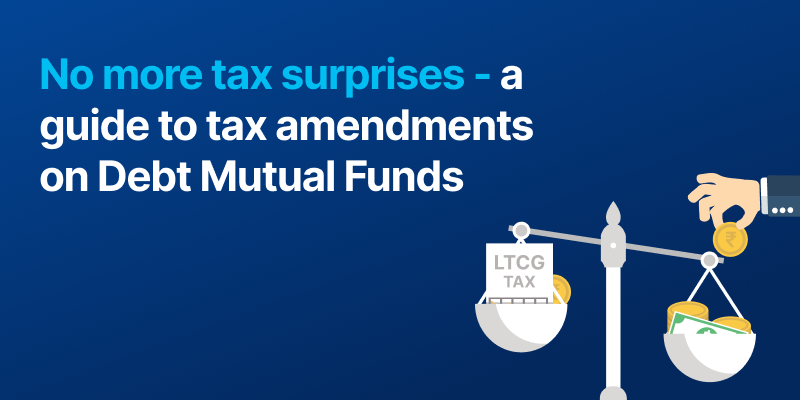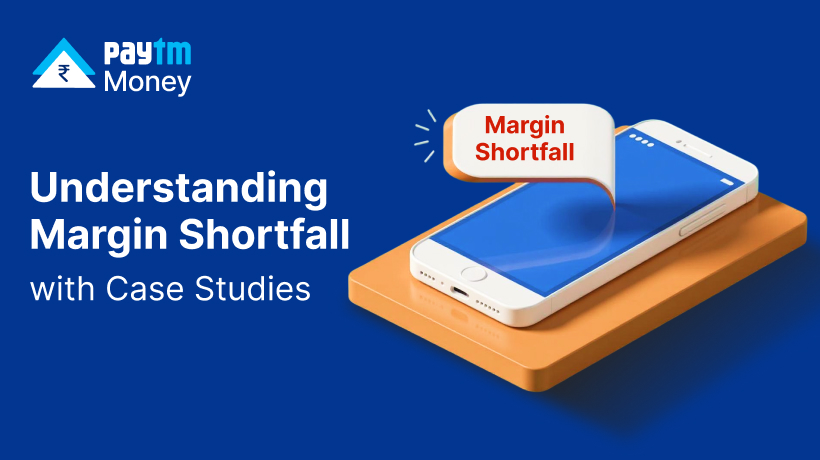Debt Mutual Fund gains face new tax rules: All you need to know9 min read
On Friday, 24th March, Lok Sabha passed the Finance Bill, with a few key amendments that all capital market investors should know and understand.
But before that, something that many of us must be wondering is, weren’t we done with the Budget in February? So what are these sudden changes? Well, for that, we need to understand the Budget process first.
The Finance Minister of India presents the Budget to the parliament, which lays out the income, expenditures, and overall fiscal priorities of the government. This was done this year on Feb 1. Being a parliamentary democracy, obviously, this has to be passed by the Parliament. And here comes the Finance bill. In fact, the budget, presented by the Finance Minister, is nothing but the summary of the Finance Bill, which has to be passed by the Parliament. What matters, and what gets finally implemented, are the provisions of the Finance Bill, which was passed by the Lok Sabha on the 24th. So in essence, irrespective of what gets presented during the budget day, what matters are the provisions of the finance bill which get passed.
While typically, there aren’t too many differences between the Budget speech and the finance bill, every once in a while, you do have googlies thrown in.
This year’s finance bill is a very good example. In the Budget speech, and in the draft finance bill which came after the speech, the Finance minister sought to curb the tax arbitrage that MLDs enjoyed. Essentially, the interest income from MLDs (Market Linked Debentures) was being considered as capital gains and were getting favourable tax treatment. The budget speech put an end to this arbitrage by considering all gains from MLDs as short term capital gains and to be taxed at the investors’ marginal tax rate.
On Friday, when the Finance bill was passed by Lok Sabha, along with MLDs, all funds, which have <35% exposure to domestic equities were considered in the same bucket, i.e. all gains to be considered as short term capital gains and to be taxed at the investors’ marginal tax rate.
So this means, that the following categories of funds/securities get this unfavourable tax treatment.
- Debt mutual funds, including ETFs and target maturity funds
- Conservative hybrid funds that invest < 35% in domestic equity
- Gold ETFs and Funds
- International ETFs and funds
Earlier, all these categories of funds were considered as debt funds and were taxed as follows
- Short term capital gains (i.e. holding period < 3 years) taxed at marginal rate
- Long term capital gains (holding period > 3 years) taxed at 10% without indexation and 20% with indexation (Indexation is basically adjusting your cost of purchase for inflation)
With this move, not only are capital gains benefits gone, indexation benefits are also gone, which means, all your gains, irrespective of your holding period and the inflation rate in that time period will be taxed at your marginal rate.
Now you can understand the frustration and anxiety among investors, as it affects not just debt funds, but Gold and international funds.
FYI, this affects just fresh investments in these schemes done after 1 Apr 2023. Existing investments will continue to get the favourable earlier tax benefits.
Another point to note is that this amendment, brings in a third category wrt capital gains taxation.
1. Funds with <35% investment in domestic equity
Tax Rules
All gains taxed at marginal tax rate, irrespective of holding period/indexation benefit
Scheme Examples
- ICICI Prudential Regular Savings Direct Growth Fund
- Kotak Debt Hybrid Fund Direct Growth
- Aditya Birla Sun Life Regular Saving Direct Growth
2. Funds with >35% in domestic equity but <65% in domestic equity (these would be some moderate and aggressive hybrid funds)
Tax Rules
These funds will enjoy the older tax regime, i.e. gains with holding period < 3 years to be taxed at marginal rate, and gains with holding period >3 years taxed at 10% (or 20% with indexation benefits).
Scheme Examples
- Mirae Asset Equity Saving Fund Direct Growth
- ICICI Balanced Advantage Direct Growth
- Tata Balanced Advantage Fund Direct Growth
3. Funds with >65% investment in domestic equities
Tax Rules
Equity taxation, i.e. 15% STCG and 10% LTCG
Scheme Examples
- ICICI Prudential Equity & Debt Direct Fund Growth
- JM Equity Hybrid Fund Direct Growth
- Bank of India mid & small cap Equity & Debt Fund Direct Growth
What this means for investors, and what are your options?
Lets start with Debt funds – If you are investing in debt funds, frankly, this amendment puts Mutual funds, FDs and direct investment in bonds on the same tax bucket. So this would be a good opportunity for you to consider all these alternatives.
Mutual funds still offer benefits in terms of liquidity, professional fund management, and ability to invest even small sums of money systematically.
1. Funds with <35% investment in domestic equity
- Tax rule for investment before 31st March, 2023
Indexation benefit.Taxed Long term capital gain & short term capital gain depending on period of holding
- Tax rule for investment after 31st March, 2023
NO indexation benefit, taxed at marginal tax rate.
- Scheme example
ICICI Prudential Regular Savings Direct Growth Fund
Let’s say as an investor you have invested Rs.5,00,000 in the above scheme. Assuming you are in the 30% tax slab.
Amounts in Rs

FDs offer simplicity and convenience. With banks hiking their FD rates, it might be a good opportunity to lock in higher rates. While FDs offer convenience, liquidity is poor (you might have premature penalties), and there is TDS and the tax liability also happens every year, unlike MFs, where the tax incidence is only at the point of redemption.
A very interesting option that opens up for debt investors is direct investment in Bonds. Earlier, taxation for bonds was similar to FDs, i.e interest was taxed at marginal tax rate. With this amendment, bond investments are similar to MF investments from a tax perspective. Direct investment in bonds gives you the ability to
- Choose the level of risk you want to take (you have Govt bonds, AAA rated bonds, and high risk bonds)
- Choose the tenure of investments (you have options from 1 month to 20 years)
- Choose the type of cash flow you want (you have options from monthly, quarterly, annual and cumulative interest payment)
In fact, this amendment has brought the biggest fillip to direct bond investments, and this places it on an even keel with MFs and FDs, with distinct benefits of going with bonds (more flexibility as compared to MF, better returns when compared to FDs)
Finally, as debt investors, you should consider PF (both EPF, PPF Sukanya Samriddhi etc) type of investments as the gains in these are tax exempt. While you have a long lock in period with these instruments, you do get assured returns and no taxation on gains.
Do note that with this move, you will see a lot of new funds in the market which will try to play this change in tax rules. You will have funds that invest 65% in debt and 35% in arbitrage, just to get the 35% allocation to equities. Conservative hybrid funds that invest 35% in equity can also be considered While these might seem attractive do remember that
- Such tax arbitrages will inevitably be removed
- Arbitrage opportunities are not a like for like replacement for debt. They can replicate liquid fund returns, but not credit risk or interest rate risk
- Finally, with conservative hybrid funds (that invest 35% in equities), remember that you are taking equity risk. Consider this equity allocation as a part of your overall asset allocation
Now let’s look at if you are an investor in Gold. Your options are
- Gold ETF and funds
- Physical Gold
- SGBs
Gold funds and ETFs will fall in the new tax regime, i.e. all gains taxed at marginal tax rate, irrespective of holding period.
Physical gold would continue to be taxed in the older way, i.e. short term gains at marginal rate, and long term gains at 10% (or 20% with indexation). But do remember that with physical gold, every time you do a transaction you have a GST impact.
Finally, SGBs. With this amendment, SGBs become a very attractive avenue to invest in Gold. Not only do you get an additional 2.5% return over gold, if you hold till maturity, your gains are tax exempt.
So in summary
- If you are playing for short term movements in the price of gold, Gold ETFs/funds might still be the best avenue (given the transaction costs associated with physical gold)
- If you are investing for the long term, and as per an asset allocation plan, SGBs are the best way to get exposure to gold
Finally, let’s consider if you want international exposure.
Frankly, you have very few options. Direct investment abroad via LRS is an alternative, but this budget introduced 20% TCS (Tax collected at source). While this can be adjusted against your tax liability, this means that when you remit Rs. 100, you essentially have only Rs. 80 to invest. In terms of taxation, gains with a holding period < 2 years are taxed at slab rate, and for > 2 years, gains are taxed at 20%, with the benefit of indexation. You would also have to consider additional charges/FX impact of platforms that offer LRS investment options.
Given these issues, the simplicity of foreign mutual funds, even with the adverse taxation, international MFs and Fund of Funds might still be the best way of getting international exposure.
Phew. That was a lot to digest. So what’s the bottom line? Well the bottom line is that with this budget, getting good post tax returns in Debt is going to be a challenge. Look at all options comprehensively (EPF, PF, FDs, bonds, MFs) before you take any decision. Also, don’t increase your equity allocation just because of this reason. Your asset allocation should be based on your risk profile and your return expectations. Do not let such tax changes significantly affect your asset allocation decisions. As always, consult a registered investment advisor for building your financial plan.
Happy investing!
Disclaimer – Investments in the securities market are subject to market risks, read all the related documents carefully before investing. This content is purely for information purpose only and in no way to be considered as an advice or recommendation. The funds/securities are quoted as an example and not as a recommendation. Paytm Money Ltd SEBI Reg No. Broking – INZ000240532. NSE (90165), BSE(6707) Regd Office: 136, 1st Floor, Devika Tower, Nehru Place, Delhi – 110019. For complete Terms & Conditions and Disclaimers visit: https://www.paytmmoney.com/stocks/policies/terms




